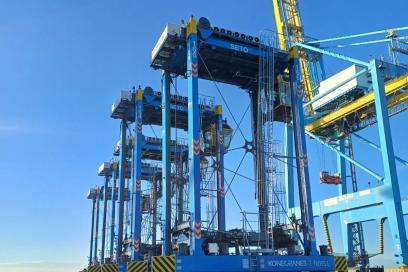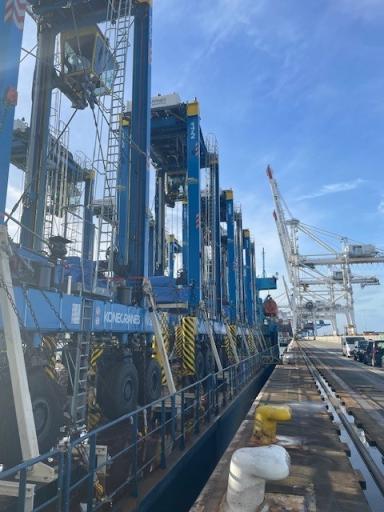- ABOUT US
- CARGO
- A multi-sector focus
- A maritime service offering in the first rank
- An attractive multimodal offering
- An expanded short sea service offering
- Port terminals and shared-use quays
- High-quality ship services
- Fluid, facilitated goods throughput
- A port that puts its performance figures in the public domain
- PASSENGERS
- MULTIMODALITY
- ECOLOGICAL TRANSITION
- INNOVATION
More virtuous and economical, these 12 hybrid-powered equipment are part of TiL MSC's ambitions to reduce CO2 emissions from its Terminaux de Normandie handling activities. These also allow to make fuelsavings. The cabs ergonomics have been redesigned, safety and driver comfort are also improved.
New machines should be operational by mid-January 2024, after a period of technical testing and handling by the crews. They join the 24 units build by Kalmar and already received by TiL MSC over the 2022-2023.
Built in Poland by the Finnish company Konecranes, the new equipments were transported to the port of Le Havre by Le Meri, a heavy lift vessel. Teams from TNMSC and Dockers de Normandie, in collaboration with Konecranes, carried out their unloading and handling.
An ambitious investment plan
This acquisition is part of an initial investment package of 200 million euros, which forms an integral part of the major 900 million euro investment plan announced by Til MSC to modernize its Le Havre port terminals. Eventually the aim is to triple the terminal’s capacity to welcome and handle the largest ships currently in service and those to come.
Next step: the delivery, staggered from the 4th quarter of 2024, of the 9 electric mega-gantries cranes ordered last April as part of the first investment tranche.
A new order for twelve straddle carriers is also under consideration, to bring the Le Havre terminal up to full capacity in its current configuration
Did you know it? The investments made by TiL MSC, coupled with the projet of « chatière », the development of the rail mode and the connection of ships to the electrical quayside, meet the development challenges of the Seine axis and contribute to making HAROPA PORT one major gateway to the European market.

